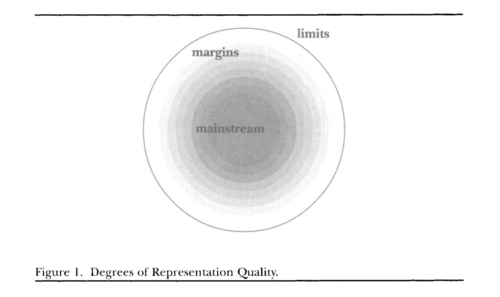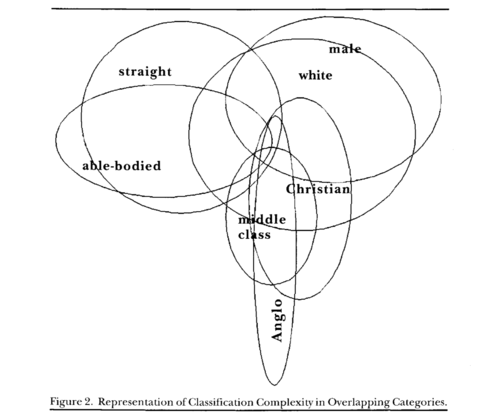User:Simon/spatial classification: Difference between revisions
No edit summary |
No edit summary |
||
| Line 1: | Line 1: | ||
[[File:Olson mapping beyond deweys boundaries.a4.pdf]]<br> | [[File:Olson mapping beyond deweys boundaries.a4.pdf]]<br> | ||
Hope A Olson's text "Mapping Beyond Dewey's Boundaries" on spatial representations in classification systems brings up several thoughts. Stating that "classifications are locational systems" suggests that spatial representations can be used with various effect; describing, exposing, and when used as metaphors, shifting. | Hope A Olson's text "Mapping Beyond Dewey's Boundaries" on spatial representations in classification systems brings up several thoughts. Stating that "classifications are locational systems" suggests that spatial representations can be used with various effect; describing, exposing, and when used as metaphors, shifting the discourse. | ||
'''1. Spatial representation of classification systems reveals the ideological conditions that form them.''' | '''1. Spatial representation of classification systems reveals the ideological conditions that form them.''' | ||
Olson refers to spatial representations of classification systems in the form of diagrams | Olson refers to spatial representations of classification systems in the form of diagrams. | ||
[[File:Olson zipf.png|500px]] | [[File:Olson zipf.png|500px]] | ||
The first diagram is a Zipf-based one, with the idea of a mainstream core that diffuses towards the margins. | |||
[[File:Olson venn.png|500px]] | [[File:Olson venn.png|500px]] | ||
The second is a Venn diagram that illustrates how "mainstream" or "core" descriptors actually eventuate in very small "cores" due to limitations by Boolean "ands'. Venn diagrams operate on the basis of duality - something is or isn't part of a set. | |||
'''2. The concepts of "paradoxical space" and "rhetorical space". ''' | '''2. The concepts of "paradoxical space" and "rhetorical space". ''' | ||
Revision as of 10:49, 1 June 2019
File:Olson mapping beyond deweys boundaries.a4.pdf
Hope A Olson's text "Mapping Beyond Dewey's Boundaries" on spatial representations in classification systems brings up several thoughts. Stating that "classifications are locational systems" suggests that spatial representations can be used with various effect; describing, exposing, and when used as metaphors, shifting the discourse.
1. Spatial representation of classification systems reveals the ideological conditions that form them. Olson refers to spatial representations of classification systems in the form of diagrams.
 The first diagram is a Zipf-based one, with the idea of a mainstream core that diffuses towards the margins.
The first diagram is a Zipf-based one, with the idea of a mainstream core that diffuses towards the margins.
 The second is a Venn diagram that illustrates how "mainstream" or "core" descriptors actually eventuate in very small "cores" due to limitations by Boolean "ands'. Venn diagrams operate on the basis of duality - something is or isn't part of a set.
The second is a Venn diagram that illustrates how "mainstream" or "core" descriptors actually eventuate in very small "cores" due to limitations by Boolean "ands'. Venn diagrams operate on the basis of duality - something is or isn't part of a set.
2. The concepts of "paradoxical space" and "rhetorical space". Paradoxical space is described in a similar way to the paranodal; being "both inside and outside, center and margins".
How to utilise a "paradoxical space"? The text seems to suggest focusing on connections, relationships between subjects rather than differences? What could an associative classification system look like?
The space of a page is crucial in the printed format - the text block excludes the margin - clearly delineating what is recognized as authored, and what is not. However, some formats of digital books (e.g. EPUB) do not have the notion of a page. There is the space of the screen, but this is mutable, whereas a printed page is not.
universality
It doesn't seem that all formats of classification schemes should be merge all formats or classification schemes into one - this is in itself a classification of classification.
